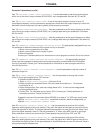
TOSHIBA
9 - 7
Parameter Explanations (cont'd)
Item 37 JUMP FREQUENCY BAND #1 - Enter the bandwidth for JUMP FREQUENCY #1. The value
entered here will be added to and subtracted from JUMP FREQUENCY #1 to determine the upper and
lower frequencies of the deadband.
Item 38 JUMP FREQUENCY #2 - see item 36.
Item 39 JUMP FREQUENCY BAND #2 - see item 37.
Item 40 JUMP FREQUENCY #3 - see item 36.
Item 41 JUMP FREQUENCY BAND #3 - see item 37.
Example of Jump Frequency:
Suppose JUMP FREQUENCY #1 is set to 30 Hz and JUMP FREQUENCY BAND #1 is set to 5 Hz.
Suppose a frequency reference starts commanding 0 Hz and slowly increases. The drive's output
frequency slowly increases. When the reference hits a level that is commanding 25 Hz (30 - 5 Hz),
the drive's output frequency stays at 25 Hz even though the reference continues to increase.
When the reference hits a level that commands 35 Hz (30+5 Hz), the drive accelerates (using the
selected acceleration time) from 25 Hz to 35 Hz and continues to increase as the reference
increases. During a decel, the drive will "stick" at 35 Hz until the reference hits a level that
commands 25 Hz, at which time the drive decelerates (using the selected decel time) from 35 Hz
to 25Hz, and resumes following the reference.
Item 42 PWM CARRIER FREQUENCY - Use this function to change the frequency of the motor's acoustic
noise. Derate its current capability (110%<= 8Khz, 90%>=10Khz).
Item 43 INPUT TERMINAL SELECTION - With this parameter set to "0", the drive's input terminals, when
shorted to "CC", have the following default functions:"R" terminal gives reverse run command, "F" terminal
gives forward run command, "RES" terminal resets a fault, "ST" terminal enables drive, "S1", "S2", "S3",
and "S4" terminals give preset speed references. The user has the option of changing the function as-
signed to any of the G3's input terminals by programming a "1" into item 43 and programming the following
parameters as necessary.
Item 44, "R" INPUT TERMINAL FUNCTION - sets the function realized when the "R" terminal is shorted
to "CC". Default setting gives a reverse run command. See page 9-9 for codes for other available
functions.
Item 45, "S1" INPUT TERMINAL FUNCTION - sets the function realized when the "S1" terminal is
shorted to "CC". Default setting gives a preset speed reference. See page 9-9 for codes for other available
functions.
Item 46, "S2" INPUT TERMINAL FUNCTION - sets the function realized when the "S2" terminal is
shorted to "CC". Default setting gives a preset speed reference. See page 9-9 for codes for other available
functions.
Item 47, "S3" INPUT TERMINAL FUNCTION - sets the function realized when the "S3" terminal is
shorted to "CC". Default setting gives a preset speed reference. See page 9-9 for codes for other available
functions.
Item 48, "S4" INPUT TERMINAL FUNCTION - sets the function realized when the "S4" terminal is
shorted to "CC". Default setting gives a preset speed reference. See page 9-9 for codes for other available
functions.
Item 49, "F" INPUT TERMINAL FUNCTION - sets the function realized when the "F" terminal is shorted
to "CC". Default setting gives a forward run command. See page 9-9 for codes for other available


















